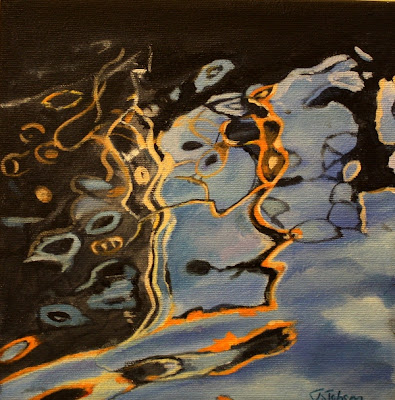Surfacing here on the very last day of the year to wish all Watermarkers and our readers a very Happy 2011! I have had fewer watery pieces to show this year, but here are some from my recent mid-December trip to Norway. They will already be familiar to most of you, I think.
I am purposely not overplanning my art life for 2011, but one thing I know---water will figure in it, somehow, somewhere, and I will be here sharing it! I am so grateful to be a continuing part of this talented group.
Friday 31 December 2010
Sunday 26 December 2010
Saving the boat
I created this watercolour over a period of time. It was one that I sketched out on a half sheet (15" x 22" ) of 200lb paper a few months ago, then abandoned it for awhile. I haven't slept well for a few nights so was up very early (4am!) and decided to play around with it again. Kind of kill or cure.
I added layers of wash to the water and detail to the little dory to bring it to a more finished level. There are flaws in it, but there are also ways around flaws if I want to preserve this piece from the bin.
1. Composition. The boat is dead centre of the painting. Dead centre is called so because it makes the painting uninteresting and doesn't let the eye wander around the piece, picking up other elements.
2. The horizon line. I painted this on a fairly flat surface without standing back as much as I should to see my progress. As a result, the horizon line is tilted upwards on the right.
So how to correct this? Instead of scrubbing back and risking making it worse, simple crops can help save this piece.
The first option is to eliminate the horizon altogether, concentrating on the dory and the water. This isolates the boat and doesn't give any options to the viewer but to look at it, but still has the challenge of a central focal point.
The second option is to crop from the side as well as the horizon. This knocks the focal point (the dory) off centre and allows the viewer to examine the changes in values in the water, sending the eye around the painting and back to the dory again.
The crop can be from either side depending on how much space there is. In this option, cropping the left doesn't allow a lot of space to the right and brings the dory into the foreground more, reducing the overall size of the piece.
Which would you choose?
Labels:
cropping paintings,
dory,
jeanette jobson,
water surface,
watercolour
Tuesday 7 December 2010
Water studies
While I have several projects on the go at once, there are several water-related ones that keep jumping into my head and insisting that I make some inroads on them.
Reflections on water is the predominant image that calls me and I've done a couple of studies in preparation of larger pieces. I'm a firm believer in doing studies that let me work out most of my mistakes before I translate them onto a large canvas.
The first is a simple water pattern in late evening on a local pond. Its not complete in terms of light but enough information is there to make it recognizable for what it is. This is done on in oils on a 6 x 12 gallery canvas that I reclaimed from another start that didn't go as planned.
The second piece is strong reflections on the surface of slowly moving water. The distorted shapes create an abstract pattern and lots of negative shapes to work from. Its a bit of a puzzle to paint but a little concentration helps as well as the small size of just 6 x 6 in acrylics. I wanted to ensure that I would like to do this before I went larger with this one. I drew this up on a 20 x 20 canvas and will work on it as and when I can.
Labels:
acrylics,
jeanette jobson,
oils,
reflections,
water studies
Subscribe to:
Posts (Atom)






